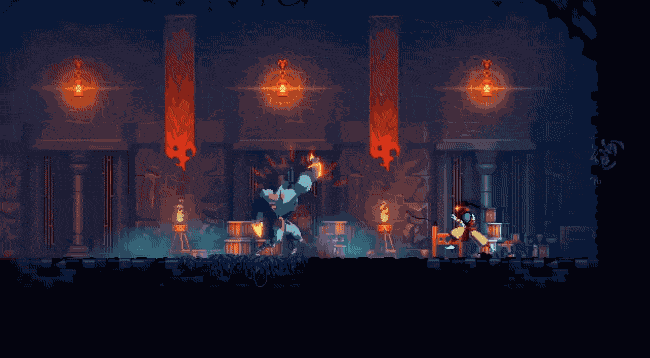Dead Cells was one of those games that I always wanted to give a go but never quite got around to. There was always the next big triple-A title to play, that fourth run of Skyrim to get going… We’ve all been there. Bleak Falls Barrow is like a second home. But after finally picking up a Nintendo Switch, I decided to give Dead Cells a shot.
I am so glad that I did.
The official genre description of Dead Cells appears to be that it is a “Roguevania” game, this being a combination of “roguelike” and “Metroidvania”. But what the hell does that all mean?
What does “Roguevania” mean?
A roguelike game is essentially one that follows the “dungeon crawler” mindset. Influenced by tabletop games such as Dungeons & Dragons, these games often feature seemingly endless replayability through the use of procedurally generated levels. According to the Berlin Interpretation, roguelike games should also include permadeath, turn-based combat, and resource management.
Dead Cells includes a number of these factors, so it is rightfully apart of the genre. I find that it handles permadeath particularly well. The player actually controls an ethereal slime who appears to take over a series of headless corpses. When you die, you lose everything and start anew. I guess the slime doesn’t have pockets?
A Metroidvania title is a subgenre in which games are placed if they are said to follow the design and mechanics of the Metroid series or the early Castlevania games. They feature large inter-connected maps, play as platformers, and feature boss fights for important items to continue exploration. Dead Cells has all this and more. Russ Frushtick from Polygon has included Dead Cells in his 2018 discussion on what makes a great Metroidvania title in the modern age of gaming. Check it out below:
Dead Cells’ Gameplay Is Smooth Like Buttah
Much like any game in this portmanteau genre, Dead Cells is no exception to excellent gameplay. The controls are simple and easily make it a joy to play. With Dead Cells’ dodge feature, you can effortlessly roll through the levels, hacking and slashing at will. There are a variety of weapons, all of which feel different to use and force you to change up how aggressively you hack and slash. For a game that looks fairly simple on the surface, there is a great depth in the items and upgrades you can acquire throughout.
Dead Cells’ weaponry is categorized by the player’s three stats: Brutality, Tactics, and Survival. These three stats are scaled differently depending on what upgrades, items, and skills the player has and often add damage modifiers to weapons (such as bleeding effects or frost damage). There’s also a selection of traps and turrets the player can use to help them. These are primarily scaled by the tactics skill, but some are attributed to two stats.
Much like any roguelike, if you die… You lose it all. Every trap, weapon, scaled up stat… It’s disheartening, but that is what makes cells so important.

Cells are an in-game currency, alongside gold, that the player collects from hacking and slashing. Gold can be used to buy items and open doors. Cells, though, are spent on upgrades. Thankfully, these are permanent for all playthroughs. The only problem is that you can only spend the cells at the end of each area with either The Collector or at The Blacksmith’s Legendary Forge. If you die with any cells on you, they’re lost. The roguelike is as punishing as it is rewarding.
Dead Cells’ Environments Are Deep
Graphically, Dead Cells is stunning. Motion Twin has embraced the retro-looking pixelated graphics to excellent effect. Each level is wonderfully detailed, both in the foreground and the several background layers. What I find amazing is that it doesn’t clutter the screen. Initially, I thought it would all become a lot, but this isn’t the case. Instead, it makes each environment feel much more open and whole. The combat is also full of blood splatters, explosions, and fire (dependent on weapon choices). Who can have any complaints about that, right?

Dead Cells’ Protagonist Is Generic But Memorable
What Motion Twin has done well in Dead Cells is bring character to a fairly generic-looking, mute, disposable playable character. Right from the start, I found that they were more than just a lifeless husk inhabited by a strange sentient slime. While the protagonist is largely mute, there are text boxes that convey some internal thoughts. For example, they seem less than amused when they stumble across a pile of corpses which all look remarkably similar.
The internal thoughts that pop up sporadically convey confusion and curiosity and more often than not, I found them amusing.
I truly found it hard to fault, which is unusual because I could complain about The Witcher III’s combat for hours. With Dead Cells, though, it was just a joy from the beginning. This review was written with the Nintendo Switch version of Dead Cells, but the game is available on nearly everything. The seamless pick-up and play of the Nintendo Switch make Dead Cells a perfect title for the console. Although it wasn’t, the game feels like it was made for handheld gameplay. I couldn’t imagine getting as much enjoyment from it on a console. Weird, I know.
[penci_review]
Check out here for a run-down on what our new Review System means and keep an eye out for the latest reviews from the Gamezo writing team!
Like what you see? Don’t forget to share our work with the buttons below! Also, be sure to follow @GamezoGG on Twitter and check out our YouTube Channel for more great content from the Gamezo Team!

